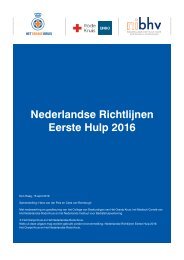Thesis-Anne-Vos-Masters-SBR-and-EU-Law-3
Thesis-Anne-Vos-Masters-SBR-and-EU-Law-3
Thesis-Anne-Vos-Masters-SBR-and-EU-Law-3
Create successful ePaper yourself
Turn your PDF publications into a flip-book with our unique Google optimized e-Paper software.
2.3.1.3 Seismicity<br />
The risk of seismicity is according to the environmental impact assessment, made by the<br />
Commission, not particularly great, but when it comes to the public's opinion this concern is ranked<br />
high. Earth tremors might happen during the process of fracking <strong>and</strong> the injection under high<br />
pressure. Minor earth tremors have already occurred in the United Kingdom (by wells of Cuadrilla<br />
Resources) 63 <strong>and</strong> in North America, Ohio. It is often argued that earth tremors are not specific for<br />
shale gas projects. They e.g. also occur during geothermal activities. According to the experts,<br />
there is not a high risk of seismicity particular to shale gas activities. 64 However, this does not<br />
eliminate the risks <strong>and</strong> dangers of seismicity. In the Netherl<strong>and</strong>s, this fear is also considered high,<br />
partly due to the recent earthquakes in Groningen, caused by natural gas extraction.<br />
2.3.2 Local impacts<br />
Shale gas activities require wide areas for its extraction, in contrast to conventional resources. The<br />
concessions granted in several MS differ now from 300 km2 in the Netherl<strong>and</strong>s to 2900 km2 in<br />
Denmark, with special attention to a concession in Pol<strong>and</strong> of 87000 km2. 65 For the extraction of the<br />
shale gas, several wells <strong>and</strong> infrastructure are needed. This will also result in a lot of road traffic. 66<br />
After all, the resources, materials <strong>and</strong> waste should be transported to <strong>and</strong> from the site. Road<br />
traffic also means air pollution, noise disturbance <strong>and</strong> accidents. This could moreover lead to "l<strong>and</strong><br />
fragmentation, l<strong>and</strong> take (l<strong>and</strong> being turned into an artificial surface, AV) <strong>and</strong> disturbance to<br />
biodiversity." 67 In the U.K. it was estimated that the extraction of shale gas could lead to 7.000-<br />
11.000 truck visits for the development of 10 wells. This would have an enormous impact on the<br />
road network surrounding the well-pad. 68<br />
2.3.3 Transparency <strong>and</strong> public consultation<br />
Shale gas extraction also suffers from problems by the acceptance of the public. Besides the fact<br />
that the public is afraid of the mentioned environmental concerns (previous paragraph) <strong>and</strong> the lack<br />
of regulatory framework (next chapter), it is also concerned about the level of precaution,<br />
transparency <strong>and</strong> consultation of the shale gas projects. 69 This appeared from the Commission'<br />
consultation (held between 20 December 2012 <strong>and</strong> 23 March 2013). 70 Here, the public points out<br />
the lack of information with regard to the composition of fracturing fluids <strong>and</strong> geological<br />
conditions. 71 Often it is even the case that this information is kept secret.<br />
This lack of public trust is a problem for the development of shale gas activities. Due to (still<br />
unresolved) concerns, citizens oppose <strong>and</strong> protest against the activities, especially when the<br />
activities will be explored near their homes ('not in my backyard'-effect). This could slow down the<br />
process of shale gas extraction or prevent the project in its totality, as is already shown by several<br />
imposed moratoria in multiple MS 72 <strong>and</strong> even legal bans in France <strong>and</strong> Bulgaria. 73 Hence, it is of<br />
great importance that all these public concerns are addressed. This will stimulate their acceptance.<br />
This is also stressed by the Committee of the Regions who advocates for "m<strong>and</strong>atory<br />
implementation of wide range of effective participatory planning tools <strong>and</strong> method before<br />
63<br />
IEA Golden Rules Report (2012), p. 26.<br />
64<br />
Commission Staff Working Document Impact Assessment (2014), part 1/4, p. 26.<br />
65<br />
Commission Staff Working Document Impact Assessment (2014), part 1/4, p. 26.<br />
66<br />
Commission Communication (2014), p. 6.<br />
67<br />
Commission Staff Working Document Impact Assessment (2014), part 1/4, p. 26.<br />
68<br />
Commission Staff Working Document Impact Assessment (2014), part 4/4, p. 8.<br />
69<br />
Commission Staff Working Document Impact Assessment (2014), part 1/4, p. 32.<br />
70<br />
European Commission DG Environment, Final report: Analysis <strong>and</strong> presentation of the results of the public consultation<br />
"Unconventional fossil fuels (e.g. shale gas) in Europe", 3 October 2013.<br />
71<br />
Commission Communication (2014), p. 6.<br />
72<br />
Including the United Kingdom (although lifted as of December 2012), the Netherl<strong>and</strong>s, states in Germany, parts of Spain,<br />
Romania (also lifted in December 2012) <strong>and</strong> Denmark.<br />
73<br />
Fleming (2013),pp. 12-32.<br />
16



